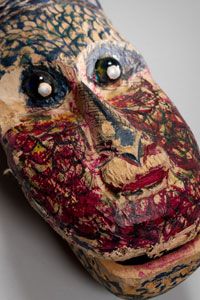Year of the Snake

A snake is seen as a painting of the animals of the Chinese zodiac on display at the “Year of the Snake: The Many Faced Snake Between Imagination and Reality” at the National Folk Museum of Korea through Feb. 25. / Courtesy of National Folk Museum of Korea

World star Psy was born in 1977, the Year of the Snake. With a new song scheduled in the new year, expectations are mounting on Psy to see whether he will repeat his mega-sucess in 2013. / Korea Times file
Hope and expectations run high with the advent of a new year. Around this time, people tend to look at the traits of the year’s animal according to the Chinese zodiac and 2013 is the Year of the Snake. The animal is the sixth in the cycle and recurs every twelfth year. It is the guardian deity of the time from 9 to 11 in the morning and the fourth month of the lunar calendar.
The snake is often associated with danger, deceit, slyness and even death, synonymous with the seduction of Adam and Eve and responsible for their ousting from the Garden of Eden.
In traditional Korean belief, the Chinese character “sa” which means snake is a homonym for death.
Yet this is not the case in Chinese culture or in its representation as a zodiac sign. Rather it is seen as having sexy, wise and materialistic qualities. Some people believe the snake as a symbol of immortality, regeneration and eternal life since it sheds its skin to be reborn and disappears for a time for hibernation. Also, when the serpent appears in a dream, it is believed as a sign for pregnancy or abundance in expectancy.
Exhibition
The National Folk Museum of Korea is holding a special exhibition titled “The Year of the Snake: The Many Faced Snake Between Imagination and Reality” showcasing 40 relevant items through Feb. 25. According to the museum, the animal is deemed an evil creature but has many faces and changeable natures with craftiness and intelligence in Korean folk tales.
The exhibition is divided into four parts ― The Snake in the Twelve Zodiac Animals; The Snake in the Imagination; The Snake in Reality; Snake Worship; and the Link between Imagination and Reality.
“Dangsajuchaek,” a popular book from the late Joseon Kingdom (1392-1910) describes people who are born in the snake year as “handsome in appearance, talented and good at both literary and martial arts.”
People have generally shied away from snakes because most of them are venomous. But the reptile was used as a medicine to provide nutrition and in the past was consumed in a form of liquor in which a whole snake is put in the bottle. People caught snakes to earn money and sometimes ate them in the hope of becoming healthier.
In the imagination, the animal appears more often through fairytales and mythology. “The snake inspires more folk tales than any other animal in the Chinese zodiac because of its stark contradictory images,” the museum said. In many Korean myths, the snake is portrayed as an incarnation of a human being who has many faces. It is also depicted as a good creature that returns favors to humans and a symbol of patience that endures enormous amounts of time to achieve its dreams. It is also seen as an avatar of revenge, greed and evil.

The snake is portrayed in “Dangsajuchaek,” a popular book from the late Joseon Kingdom (1392-1910). The book is on display at the National Folk Museum of Korea.
In folk belief, the snake was worshipped as a guardian deity to protect the house. So if a snake was found around the house, it was not chased away or caught. According to “Jejupungtorok” (Records of Jeju Customs) written by Kim Jeong during the Joseon period, the islanders faithfully worshipped the snake. Another ancient document reveals that a blue snake is portrayed as a mysterious creature with magical power, which appears to a son who is struggling to cure a disease gripping his father and helps him recover in Samcheok, Gangwon Province.
“People don’t like the snake but their interest in the creature is always high. People have double standards ― they are afraid of it but at the same time eat it. Similarly, the snake is seen negatively on one hand and deified as a mysterious being with special powers on the other. It was a representative of a human being and a friend in terms of folklore,” the museum said.
Celebrities born in Year of Snake

Snake-shaped tongs that are on display at the “Year of the Snake: The Many Faced Snake Between Imagination and Reality” at the National Folk Museum of Korea.
Big stars born in the snake year are in the limelight. Rapper and singer Psy who leapt to superstardom with the international viral hit “Gangnam Style” shines the brightest among them.
Born in 1977, Psy has been rewriting Korean pop history since the song was released in July. The video for “Gangnam Style” ranks first as YouTube’s most-viewed video. It also set a Guinness World Record for “the most liked video” on YouTube on Sept. 20 and has over a billion views. His popularity shows no sign of waning.
Other stars born in 1977 include heartthrobs Won Bin, So Ji-sub and actress Kim Hee-sun.
Won is expected to further the success he found with movies such as “Man from Nowhere” (2010) and “Mother” (2009) this year.
So starred in the film “A Company Man” after appearing in television drama “Ghost” this year while Kim returned to the small screen with “Faith” is regaining popularity after a six-year hiatus since she married.
Taeyeon, Jessica, Tiffany, Sunny and Hyoyeon of Girls Generation were all born in 1989, also in the Year of the Snake. The girl group will release their fourth album which includes the title song “I Got a Boy” today. They will resume promotional activities in Korea in January and tour Japan in February.
Veteran actresses such as Kang Bu-ja, Kim Hye-ja, Na Moon-hee were born in 1941. <The Korea Times/Chung Ah-young>
























































